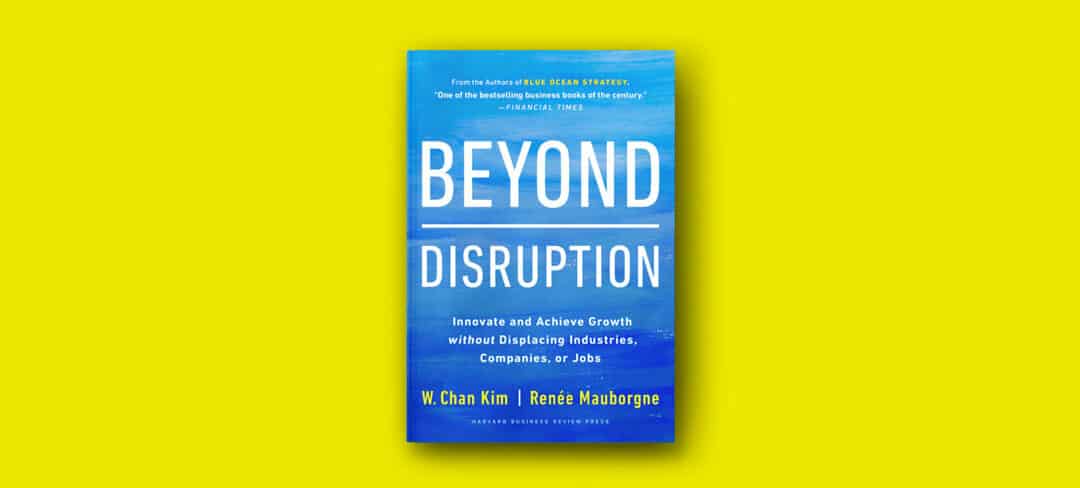Our new book, Beyond Disruption – Innovate and Achieve Growth Without Displacing Industries, Companies, or Jobs, is the outcome of a long research journey. We first sought to expand the frontiers of strategy. Then, we moved on to consider innovation beyond existing industries and zero-sum logic to the creation of brand-new markets based on positive-sum thinking.
Our first book, Blue Ocean Strategy, challenged the existing field of strategy. We asked why strategy should only be about how to compete instead of also being about creating “blue oceans” of new market space. As the energy around blue oceans and Blue Ocean Strategy took off, our second book, Blue Ocean Shift, explained how organisations stuck in the “red ocean” of intense competition could move from competing to creating in a way that empowered their employees to own and drive the process for success.
With Beyond Disruption, we dive into the field of innovation and continue our research into creating new industries in a positive-sum way, where profit and growth can be achieved in harmony with society. Here are five key insights from the book we believe are essential to organisations and our economies – both today and in the future.
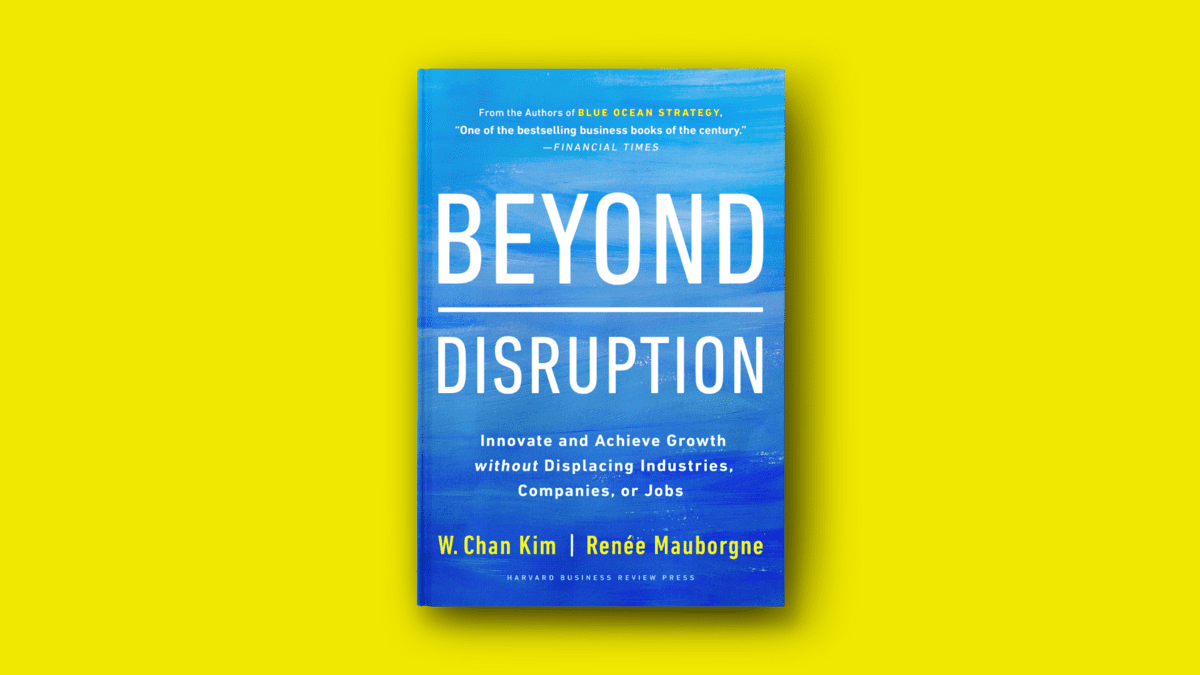
1. Innovation does not have to be disruptive
For the past 20 years, “disruption” has been the battle cry of business. Calls for disruption have rung out across Silicon Valley, corporate boardrooms, the media and at business conferences around the globe. Not surprisingly, many have come to view disruption as practically a synonym for innovation.
But is disruption the only way for companies to innovate and grow? As our research and new book bring to light, the answer is no. It may be what people talk about, it’s certainly important and it’s all around us. But the overriding focus on disruption has led us to largely overlook an alternative path to innovation and growth that requires no displacement. It’s what we call nondisruptive creation, or creation without disruption.
Nondisruptive creation generates new industries and strong growth, but without leaving a trail of failed companies, lost jobs and destroyed markets. It offers immense potential to innovate new markets where none existed before. If we could better understand this other form of market-creating innovation, we would be better equipped to achieve it.
This insight is the foundation of Beyond Disruption. In the book, we explain that nondisruptive creation is a distinct new concept that can’t be defined as inventive or new technology or new-to-the-world innovation, nor can it be confined to any specific geographic market or socioeconomic level.
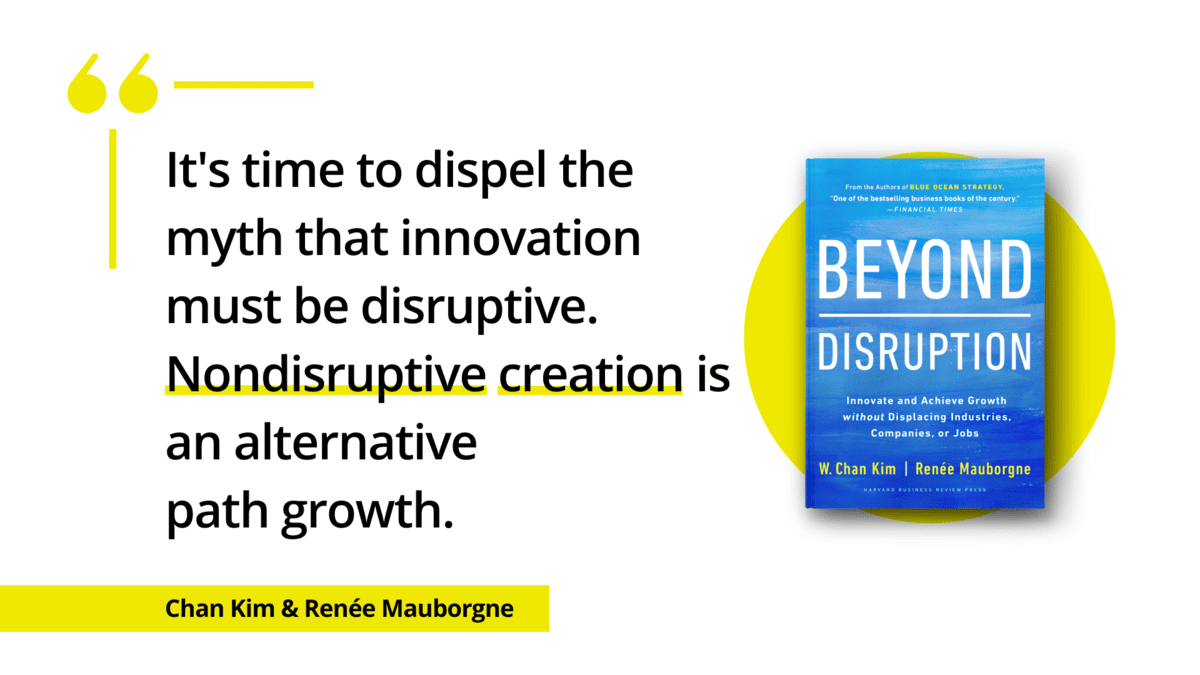
2. Nondisruptive creation is a positive-sum approach to innovation and growth where business and society can thrive together
As the world wakes up to the fact that costly negative externalities have often been imposed on society and our communities in the pursuit of profit maximisation, there has been a growing call for business to consider the impact of organisations’ actions on the broader stakeholders of society.
To answer these calls, firms are increasingly urged to pursue their strategies in a win-win manner for both the companies and society. Their innovation strategies for growth are no exception. What, then, is a viable future strategic direction for innovation as a key engine of economic growth if it must play a positive-sum role for society?
Answering the question is neither easy nor intuitive. And there are most likely various ways to achieve this goal. However, when it comes to the innovation of new markets, our research shows nondisruptive creation presents a viable path towards addressing this challenge.
Here, social good is not a sideshow but is locked into economic good by its very nature of creating without destroying, thus generating nondisruptive growth. In other words, with nondisruptive creation, social good is not achieved by how companies spend money but in the very way they make money to thrive and prosper.
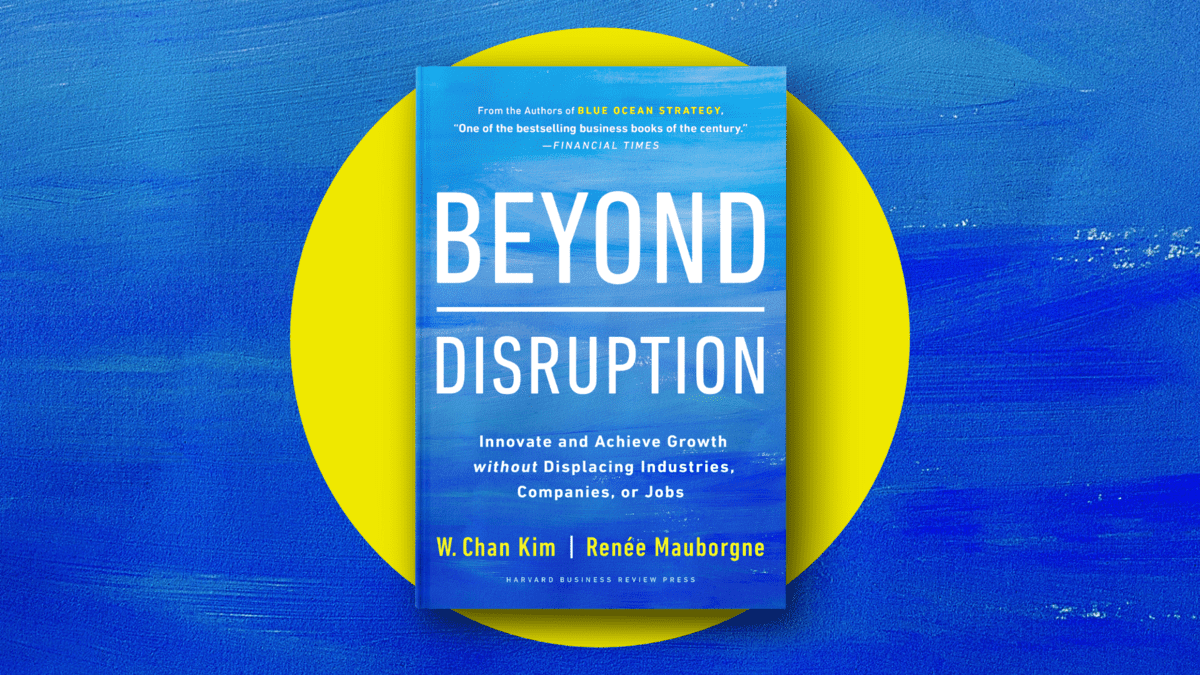
3. The relevance and importance of nondisruptive creation will grow as we face the Fourth Industrial Revolution
The fourth industrial revolution, which we are now experiencing, encompasses the advent and convergence of exponential technologies – from artificial intelligence (AI) to smart machines – that are already affecting the way we live. These new technologies are on track to trigger leaps in productivity greater than we have ever seen before. With this will come increasingly lower costs and greater efficiencies. Only, there is a hitch.
To purchase these lower-priced goods and services and enjoy the promised higher standard of living that productivity has historically delivered, it goes without saying that individuals must have jobs and a sound income. Without this, no matter how efficient, low-cost and high-quality goods and services become through technological advances, people will not have the means to purchase them.
Herein lies the double-edged sword of the fourth industrial revolution.
Although AI and smart machines are predicted to bring unimaginable efficiencies, they will do so by increasingly replacing a wide swathe of existing human jobs. While jobs have always been around for humans through technological revolutions, we have never experienced a technological revolution that has been capable of displacing so many people and so much human brain power as the one we are transitioning through right now.
This is why the concept of nondisruptive creation – creating new industries and new jobs without destroying existing ones – is so relevant to meet the challenge of lost human jobs posed by the fourth industrial revolution. With nondisruptive creation, we open a new innovation path to achieve economic growth and create new jobs without incurring the social disruption of lost jobs and hurt communities.
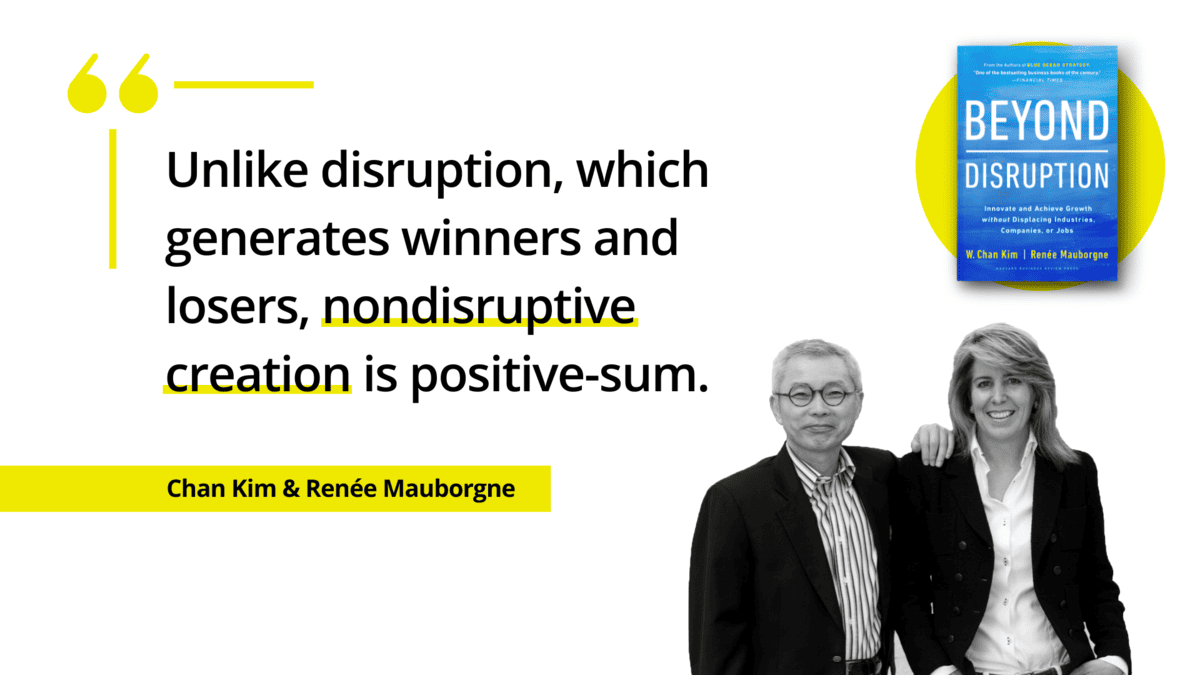
4. Disruption and nondisruptive creation both have a distinctive role and distinctive consequences
Disruption occurs when you create a new market within the parameters of existing industries. Think of how Amazon disrupted and displaced booksellers and retail stores, or how Uber did the same to the taxi industry. Nondisruptive creation occurs when you create a brand-new market outside the boundaries of existing industries, where there are no established players or markets to displace.
When industries are asleep at the wheel, ineffective, inefficient or produce a marked negative side-effect on the environment or people, they become prime targets for disruption. In contrast, nondisruptive creation does not take aim at an existing industry. Instead, it directs you to solve brand-new problems that no industry currently addresses or create fresh opportunities beyond existing industry boundaries, allowing you to achieve growth without confrontation.
Take Kickstarter, one of the many nondisruptive creators spotlighted in Beyond Disruption. Until Kickstarter came along, most people’s artistic projects went unrealised due to a lack of capital. The company changed that and created a new market beyond the bounds of the traditional finance industry; it didn’t disrupt or eat into venture capital or the banking industries’ profit or growth margins.
No one lost their job because of Kickstarter and no industry or market players were made worse off. But the artistic community flourished as upwards of US$7 billion in projects were funded and thousands of full- and part-time jobs were created. As for Kickstarter, it was profitable within three years.
Nondisruptive creation conveys four sources of advantage. One, as just alluded to, is it allows you to avoid confronting or taking on established players in achieving innovation and growth. Why poke the bear when there is a way to innovate and grow that won’t spark retaliation?
Another, perhaps more counterintuitive advantage, is it provides a viable response to full-on disruption. If your company faces disruption, you’ll want to understand how you can pivot and counter this with a nondisruptive response. In the book, we cover the two additional advantages – the internal and external stakeholder’s reaction to your attempts at innovation – and explore all four of them in-depth so organisations can broaden their opportunity horizon and responses to the changes arising in the world.
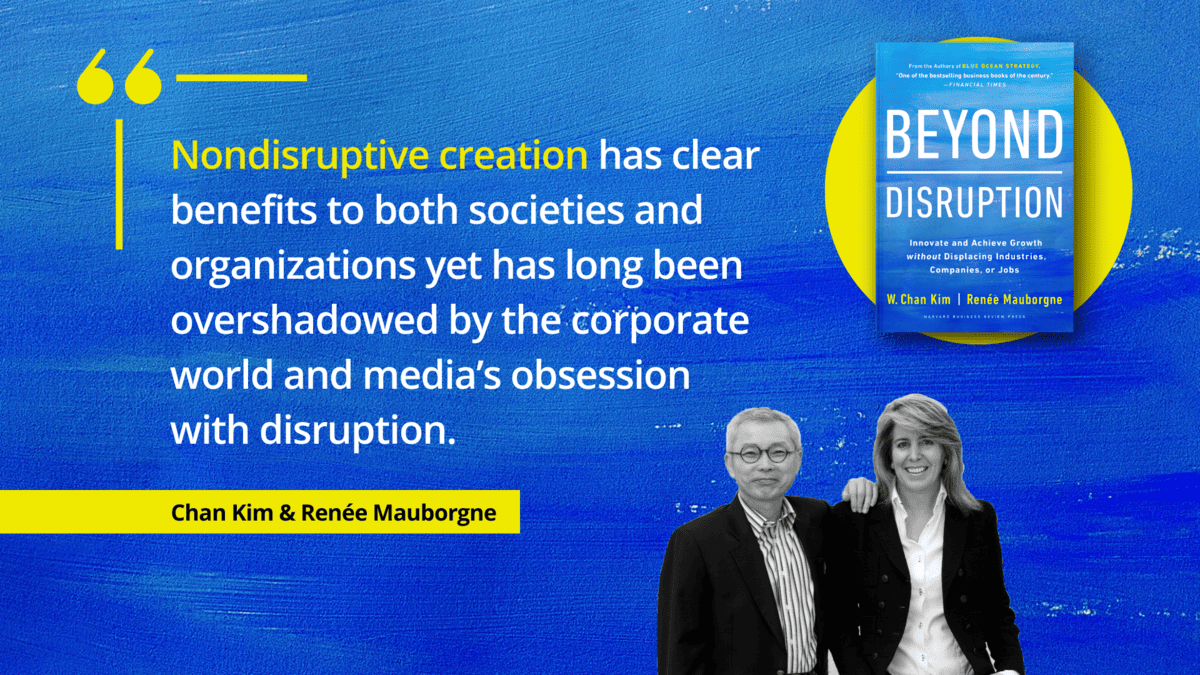
5. Nondisruptive creation can be generated by a systematic approach
We studied whether a pattern exists in how companies generate nondisruptive creation, so we could pinpoint and codify the recurring actions of nondisruptive creators. Other companies could then apply the pattern to pursue nondisruptive opportunities in a more systematic way.
Our book presents three basic steps common to organisations and individuals who have created and captured a nondisruptive new market and, importantly, provides the tools for others to make nondisruptive creation happen.
In building block one, we outline the paths to identify nondisruptive opportunities that may be on the horizon or even right in front of you – just that you hadn’t been trained to see them until now. We also address the important questions of how to assess market potential and how to scope the opportunity, so it becomes practically and emotionally feasible to act.
In building block two, we dive into how to unlock the opportunity. We introduce the assumption-implication analysis, which allows organisations to gain clarity on all the unspoken assumptions that have blocked the opportunity and how to reframe them to find a way to unlock it. Lastly, in building block three, we highlight how to secure the needed enablers and realise the opportunity in a high-value, low-cost manner.
In this way, Beyond Disruption is not only a book about an idea. It is equally a book of how to act on and seize nondisruptive opportunities in the pursuit of innovation and growth.
Edited by: Rachel Eva Lim
First published in INSEAD Knowledge, May 31 2023











